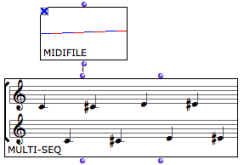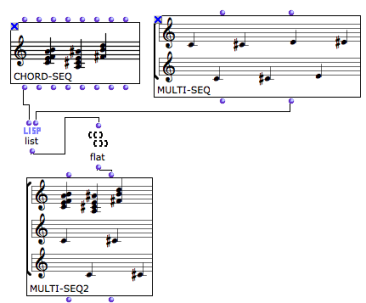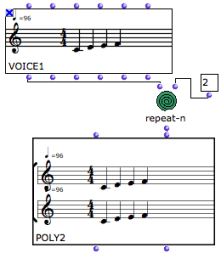| Navigation : Previous | Next |
Polyphonic Objects
The Multi-Seq Object
The multi-seq object allows to “superimpose” several chord-seqs .
![]()
Inputs and Outputs
Multi-seqs have two inputs and outputs.
-
The first input - self - takes chord-seqs or midifiles .The second input takes a list of chord-seqs .
-
The first output returns the self of the multi-seq . The second output returns a list of chord-seqs .
Applications
To convert a midifile into a multi-seq :
-
connect a midifile object’s “self” output to the “self” input of a multi-seq ,
-
evaluate the multi-seq .
The midifile is expressed as a standard musical score, which can be accessed and modified via its editor.
You will have to select a midi file when the object is evaluated. Lock the box in order not to have to choose a file again.

Modifying Score Objects
To convert a midifile and a chord-seq into a multi-seq :
-
convert the midifile into a multi-seq ,
-
connect the second output of the multi-seq , and the “self” output or the chord-seq to list .
-
If the midifile has more than one voice, use flat to get a single level list of chord-seqs.
-
Connect list or flat to the second input of the multi-seq.
 Multi-Seq to Midifile
Multi-Seq to Midifile
You can possibly convert the resulting multi-seq into a midifile with a simple connection and evaluation.
The Poly Object
The poly object allows to “superimpose” several voices .
![]()
Inputs and Outputs
The poly object has two inputs and outputs :
- The first input - self - takes polys or midi files . The second input take a list of voices .
- The first output returns the self of the poly . The second output returns a list of voices .
Applications
To create a poly out of a series of voices :
-
create a list of voices with a list function, or any other type of relevant function,
-
connect the list function to the second input of the poly and evaluate the box.

About Polys and Multi-Seq Editors
Contents :
- OpenMusic Documentation
- OM User Manual
- OpenMusic QuickStart
| Navigation : Previous | Next |